![]()
![]()
![]()
Use LEFT and RIGHT arrow keys to navigate between flashcards;
Use UP and DOWN arrow keys to flip the card;
H to show hint;
A reads text to speech;
117 Cards in this Set
- Front
- Back
- 3rd side (hint)
|
Mature Male over age of 4
|
Stallion
|
|
|
|
Mature Female over age of 3
|
Mare
|
|
|
|
Newborn usually up to about 3-4 months of age
|
Foal
|
|
|
|
Male horse up to age of 3
|
Colt
|
|
|
|
Female horse up to the age of 3
|
Filly
|
|
|
|
Foal that is no longer nursing
|
Weanling
|
|
|
|
Horse between 1-2 years of age
|
Yearling
|
|
|
|
Castrated Male
|
Gelding
|
|
|
|
Light Horse
|
Confirmation
Suited for riding Pleasure hunter stock sport show racing |
Basic Type and uses
|
|
|
Light horse weight
|
800-1000 pounds
|
|
|
|
Heavy Horse
|
Draft Breeds
Used for harness and heavy pulling (some pony breeds) |
Basic type & Uses
|
|
|
Hot Blood
|
Desert origin
Light horses Active Increased metabolism |
From, Heavy/Light and info about them
|
|
|
Heavy horse
Weight |
2000 pounds
|
|
|
|
Cold blood
|
North European origin
Heavy Horses |
From, Heavy/Light
|
|
|
Warm Blood
|
Cross between hot and cold bloods
Endurance Speed & size Strength |
|
|
|
Pony
|
Smaller type of horse
Longer body Shorter Legs |
|
|
|
Pony
Size |
14.2 hands
|
|
|
|
Miniature
|
same proportion of a full size horse
|
|
|
|
Miniature
Size |
34" and under
|
|
|
|
Donkey
|
Ass:
Have 62 chromosomes Gray Long ears "Bray" - not whinny |
|
|
|
Burro
|
Spanish for Donkey
|
|
|
|
Mule
|
Mare and male donkey (Jack)
Sterile 63 chromosomes |
|
|
|
Hinny
|
cross between Stallion and Jenny
63 chromosomes Sterile |
|
|
|
Jack
|
Male Donkey
|
|
|
|
Jenny
|
Female Donkey
|
|
|
|
Prwelski's Horse
|
One of the oldest horses left
PROTECTED |
|
|
|
Farrier
|
Person who works on horses feet (Trims & puts on shoes)
Used to be referred to as Blacksmith |
|
|
|
Hand
|
Unit of Measurement
One hand is 4" Measured from withers to ground |
|
|
|
Near Side
|
Left side
(Side we saddle from, mount on & work off of) |
|
|
|
Far Side
|
Right Side
(Approaching from this side may upset the horse) |
|
|
|
Grade
|
A non registered horse
|
|
|
|
Founder
|
Condition of the hoof
Coffin bone rotates down & through the laminae results in severe pain and inflammation of the hoof. Serious, Life threatening condition |
|
|
|
Unsoundness
|
Any defect that prevents an animal from achieving its intended use
|
|
|
|
Vice
|
Objectionable or bad habit
Often detrimental to the animal or destructive to its enviroment. Higher incident in animals kept in confinement |
|
|
|
Shying
|
Unexpected movement of an animal away from a source of pain or fear
|
|
|
|
Head shy
|
Sensitive to movements around the head.
Often try to avoid contact in the head area |
|
|
|
Out of
|
Mothered by;
referring to the female parent of an animal |
|
|
|
Get
|
The offspring of a male animal
|
|
|
|
Girth
|
Circumference of the chest just behind the withers and in front of the back
|
|
|
|
Hard Keeper
|
Animal requires more feed to maintain its body weight than animals kept under similar conditions
|
|
|
|
Borborgmi
|
Gut sounds
important to monitor Presence implies normal gastric motility and finction |
|
|
|
How often do you want to hear gut sounds?
|
1-2 times per minute
|
|
|
|
Normal Temp?
|
99-101.2
|
|
|
|
Normal Pulse?
|
28-44 bpm
|
|
|
|
Normal Respiration?
|
6-12 rpm
|
|
|
|
Dun
|
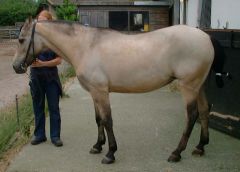
Color
|
|
|
|
Yellow hair on black skin
Gray/black mane and Tail |
Dun
|
|
|
|
Flea Bitten
|
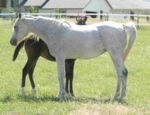
Color
|
|
|
|
Gray coat developing small dark specks with age
|
Flea Bitten
|
|
|
|
Gray coat developing small dark specks with age
|
Flea Bitten
|
|
|
|
Chestnut/Sorrel
|
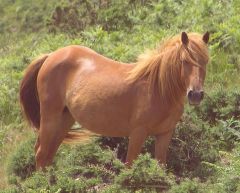
Color
|
|
|
|
Reddish gold shades
Mane and Tail varies shades of chestnut |
Chestnut/Sorrel
|
|
|
|
Black skin with white hairs
Coat lightens with age |
Gray
|
|
|
|
Gold coat with white mane and tail
|
Palomino
|
|
|
|
Red brown to dark brown
Gold with black mane, tail, and legs |
Bay
|
|
|
|
Mixture of black and brown
black legs, mane and tail |
Brown
|
|
|
|
Smokey colored body
Dark dorsal stripe dark zebra stripes on legs |
Grullo (Male)
Grulla (Female) |
|
|
|
Black or black-brown body with white hairs giving a bluish tinge
|
Blue Roan
|
|
|
|
Bay or bay-brown body with white hairs giving a red tinge
|
Red Roan
(Strawberry Roan) |
AKA name also
|
|
|
Red Roan AKA
|
Strawberry Roan
|
|
|
|
Rings of dark hair on a gray coat
decreases with age |
Dapple Gray
|
|
|
|
Large irregular patches of white and any other color but black
|
Skewbald
|
|
|
|
Large irregular patches of black and white
|
Piebald
|
|
|
|
Solid color coat with irregular splashes of white
|
Ovaro
|
Specific to Paint of Pinto Breeds
|
|
|
White base coat with irregular patches of solid color
|
Tobiano
|
|
|
|
White with dark spots all over
|
Leopard Spotting
|
|
|
|
White over hips with or with out dark spots
|
Blanket
|
|
|
|
White speckling on dark ground
|
Frost
|
|
|
|
Dominant spotting over hips
|
Snowflake
|
|
|
|
Red or blue roan with dark coloring on edges of body
|
Marble
|
|
|
|
Face Markings:
White spot between eyes on forehead |
Star
|
|
|
|
Face Markings:
White narrow stripe down face |
Stripe
|
|
|
|
Face Markings:
White mini-stripe between nostrils |
Snip
|
|
|
|
Face Markings:
Wide stripe |
Blaze
|
|
|
|
Face Markings:
AKA White face Mostly white face |
Bald Face
|
|
|
|
Face Markings:
White around lips and nostrils |
White muzzle
|
|
|
|
Leg Markings:
White stops around middle of cannon bone from coronet |
Sock
(Half stocking) |
|
|
|
Leg Markings:
White continues past fetlock from coronet (usually to knee) |
Stocking
(Full stocking) |
|
|
|
Leg Markings:
Lateral stripes on legs |
Zebra
|
Fjord
|
|
|
Other Markings:
Eel stripe Stripe extends from withers to tail |
Dorsal Stripe
|
|
|
|
Other Markings:
Permanent marking made for identification |
Brand Markings:
Heat iron Freeze Brand Tatoo |
|
|
|
Other Markings:
White hairs caused by saddle or girth sores |
Acquired Markings
|
|
|
|
Hoof Color:
Dense texture Hard wearing Blue/Black/Gray Color |
Blue
|
|
|
|
Hoof Color:
Softer |
White
|
|
|
|
Hoof Color:
Seen in spotted horses |
Striped
|
IE: Appaloosa, POA, Etc
|
|
|
Star
|

Face Marking
|
|
|
|
Stripe
|

Face Marking
|
|
|
|
Snip
|

Face Marking
|
|
|
|
Blaze
|

Face Marking
|
|
|
|
Bald Face
|
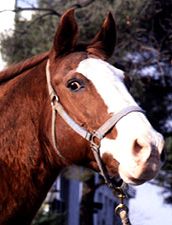
Face Marking
|
|
|
|
Sock
(Half Stocking) |

Leg Marking:
|
|
|
|
Coronet
|

Leg Marking:
|
|
|
|
Pastern
|

Leg Marking:
|
|
|
|
Stocking
|

Leg Marking:
|
|
|
|
Natural response to fright
|
"Flight instinct"
Flee from the object |
|
|
|
Blind spots
|
Directly behind
Directly in front of themselves |
|
|
|
Two ways to tie a horse
|
Single lead
Cross-tying |
|
|
|
Why do you remove the halter prior to turning out the horse?
|
Prevent from getting entangled
|
|
|
|
How far away from the horse's head should you hold the lead line?
|
8-10 inches
|
|
|
|
4 types of halters
|
Shipping Halter
Rope halter Nylon Halter Leather Halter |
|
|
|
Purpose of a Shipping Halter
|
Used to deliver horses to their new owners
|
|
|
|
Strengths/weaknesses:
Shipping Halter |
Strength:
inexpensive Adequate for temporary use Weakness: Can not be adjusted Lacks Strength Can not be a permanent halter Impossible to clean |
|
|
|
Strengths/weaknesses:
Rope Halter |
Strength:
Strong Relatively inexpensive Adjustable Variety of sizes Weaknesses: Cotton ones shrink Must frequently readjust |
|
|
|
Strengths/weaknesses:
Nylon Halters |
Strengths:
Easily cleaned Not usually affected by dampness no rotting or mildew variety of colors Weaknesses: Stretch not shrink |
|
|
|
Strengths/weaknesses:
Leather Halters |
Strength:
good for young growing horses Fits a variety of head lengths Easily repaired Weaknesses: More expensive Must be cleaned regularly Mold & Mildew |
|
|
|
Why do we use a Tail Tie?
|
Rectal palpation
Vaginal Examination |
2 reasons
|
|
|
Pasture
|
Large turn out area for grazing & self exercise
|
|
|
|
Paddock
|
Smaller turn out area for exercise
|
AKA: Corral
|
|
|
Box Stall
|
Indoor containment unit
Not less than 10 X 10 |
|
|
|
Stock
|
Close, confined (padded) area
Sturdy Allows access to most areas of the horse |
|
|
|
Two types of twitches
|
Pole with chain or rope loop on end
Metal clamp |
|
|
|
Gray
|
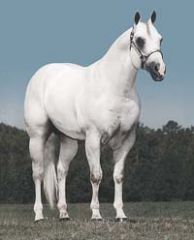
Color:
|
|
|
|
Palomino
|
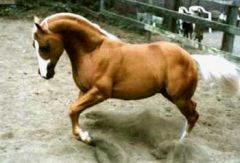
Color:
|
|
|
|
Bay
|
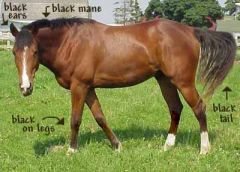
Color:
|
|
|
|
Buckskin
|
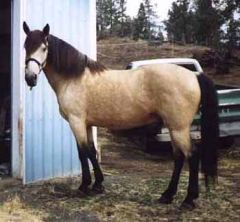
Color:
|
|
|
|
Grullo (Male)
Grulla (Female) |
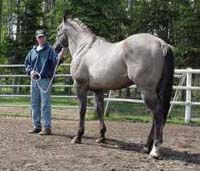
Color:
|
|
|
|
Blue Roan
|

Color:
|
|

